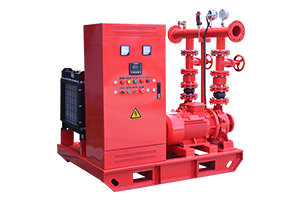Optimizing a fire pump system for large facilities involves a combination of proper planning, equipment selection, installation, and maintenance to ensure efficient and reliable operation. Here's a detailed guide:

1. Assess the Facility’s Fire Protection Needs
- Determine Water Demand: Calculate the required flow rate and pressure according to local fire codes (e.g., NFPA 20).
- Identify Fire Scenarios: Consider potential fire hazards, building layout, and occupancy type.
- Understand Code Compliance: Ensure compliance with standards like NFPA, UL/FM listings, or local regulations.
2. Select the Right Equipment
- Fire Pump Type:
- Electric Fire Pumps are ideal for facilities with reliable power sources.
- Diesel Engine Fire Pumps provide a backup when electricity is not dependable.
- Jockey Pumps maintain system pressure and reduce wear on the main pumps.
- Capacity and Pressure:
- Choose a pump with sufficient flow rate (e.g., 500-5000 GPM) and pressure.
- Consider pump curves to ensure optimal performance for peak demands.
- Pipe and Valve Sizing:
- Use appropriate pipe diameters to minimize friction losses.
- Select high-quality valves to handle large volumes of water.
3. Optimize Pump System Design
- Pump Room Layout: Ensure adequate space for maintenance and ventilation.
- Control Systems: Implement advanced controllers with monitoring capabilities to automate operations and detect faults.
- Power Supply:
- For electric pumps, ensure a stable, dedicated power supply.
- For diesel pumps, provide sufficient fuel storage and reliable starting mechanisms.
4. Install High-Quality Accessories
- Relief Valves: Protect the pump system from overpressure.
- Test Headers: Facilitate regular pump performance testing without disrupting operations.
- Pressure Maintenance: Install pressure sensors and controllers for real-time monitoring.
5. Regular Maintenance and Testing
- Weekly Tests: Conduct churn tests to check the pump's performance under no-flow conditions.
- Annual Inspections: Perform a full flow test to verify system capacity and efficiency.
- Routine Maintenance:
- Clean strainers and filters.
- Check alignment and lubrication of pump and motor couplings.
- Inspect electrical connections or fuel systems.
6. Utilize Modern Technologies
- Remote Monitoring: Use IoT-enabled devices for continuous monitoring and instant alerts.
- Energy Efficiency: Opt for variable frequency drives (VFDs) to manage energy consumption for electric pumps.
- Smart Alarms: Integrate with the facility’s fire alarm and sprinkler systems.
7. Plan for Scalability
Design the system to accommodate future expansions or changes in fire safety requirements.
8. Partner with Experts
- Work with certified fire pump manufacturers and experienced installation teams to ensure quality.
- Rely on trusted suppliers, such as Better Pump, for UL-listed, NFPA20-compliant fire pump systems tailored for large facilities.
By following these steps, you can ensure your fire pump system is efficient, reliable, and capable of handling the demands of a large facility.






